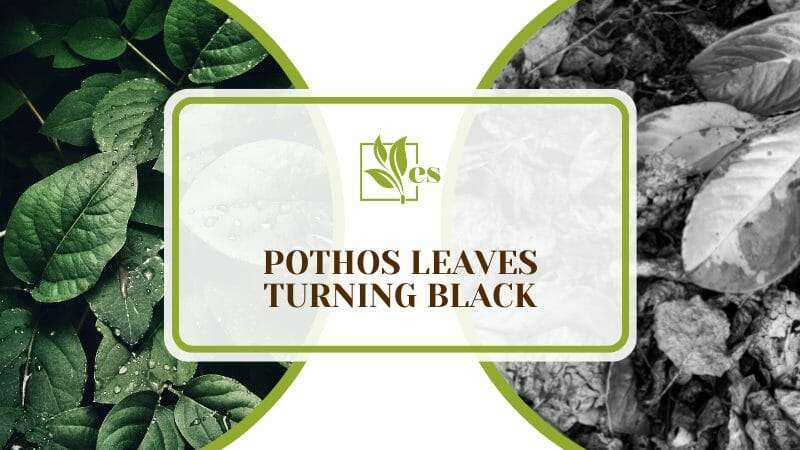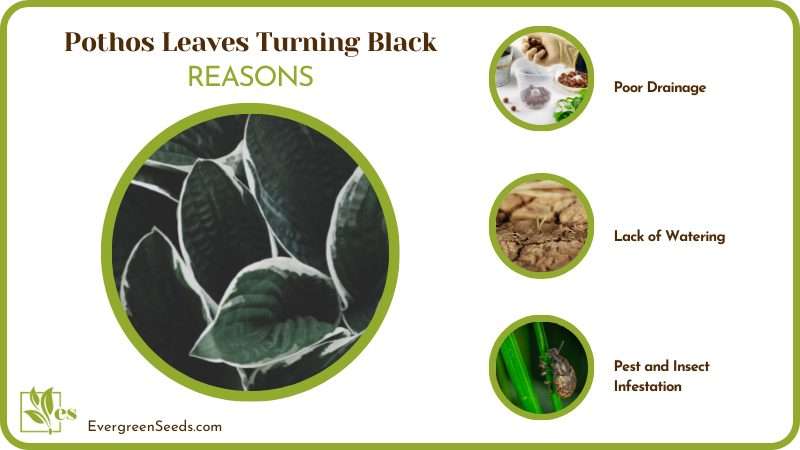If you are having a difficult experience with your pothos leaves turning black, you should know that there are several possible reasons for this such as incorrect watering, poor drainage, over-fertilizing, and more.

In this guide, we specify the possible reasons why this is happening to your beloved plant. We also provide a care guide along with all the steps that will be helpful for you to easily fix this problem.
Why Are the Leaves of My Pothos Turning Black?
Pothos leaves turn black due to overwatering, underwatering, having poor drainage, or receiving too much or not enough light, fertilizer, or temperature. It could also be because of insect infestations, diseases, or bacterial infections.
The Pothos plant has the scientific name Epipremnum aureum. It is commonly known by its famous names: Golden pothos, Devil’s Ivy, Devil’s Vine, or Money plant.
Other common names include Solomon Island’s Ivy, Marble Queen, Taro Queen, Ceylon creeper, Hunter’s Robe, Ivy arum, House plant, and Silvervine. This species from the Araceae family is native to French Polynesia and is naturalized in different parts of the world.
Pothos plants are typically grown as indoor plants and are prized for their aesthetically pleasing foliage. Its trailing stems bear heart-shaped leaves, which are sometimes variegated with green, white, and yellow. They make excellent hanging plants or plainly potted as a bundle to make a statement indoors.
Pothos plants are relatively simple to care for and are known as hardy plants that can tolerate a bit of neglect. So we understand that it might be a bit surprising to see that your marble queen pothos leaves are turning black and obviously experiencing some health issues. Let us find out and discuss the potential reasons why your pothos is experiencing such an issue.
– Overwatering
Pothos plants prefer less water rather than more because they are drought tolerant, which is why overwatering causes their leaves to blacken. It is the effect of root rot over moist conditions and can lead to death.
Pothos leaves turning black in water only when they receive an excessive amount of it. Overwatering reduces the oxygen in the soil, resulting in damage to roots and reduced level of water absorption. You should check some signs like yellowing leaves or the formation of black spots. If you see any of these signs, check whether the roots of the plants have rotted.
– Lack of Watering
In contrast to overwatering, underwatering could also be the reason for your pothos plant’s blackened leaves. Although these plants are drought resistant, they will still fall ill or, worse die if underwatering continues for a long period of time.
Underwatering or not giving the right amount of water will have the effect of wilting leaves, although this is normal for short periods during dry spells. Another symptom is black leaves, so it is important to be mindful of your watering schedule to avoid underwatering.
– Excessive Light Exposure
Another reason why your pothos leaves blacken is being exposed to an excessive amount of light. Receiving too much direct sunlight burns and scorches the plant cells, resulting in the wilting, yellowing, and darkening of the plant leaves.
– Poor Drainage
You must consider poor drainage of the soil as one of the reasons why your pothos leaves turning black. It is essential that the roots receive air by properly aerating the potting soil, so that the roots can be able to breathe and survive.
Good drainage will allow the excess water to flow and not choke your plant. By keeping the roots healthy, they will be able to absorb water effectively and transport it to the rest of the plant; otherwise, unhealthy roots will result in growth issues.
– Temperature and Humidity
Pothos plants usually thrive in indoor humidity if they receive sufficient lighting. However, during colder seasons during which there is less humidity, you will notice your pothos leaves having brown spots and then turning black. This is the result of excessively dry air, which affects plant growth.

– Pest and Insect Infestation
Although pest and insect infestation is something that is commonly experienced when growing a plant, such an issue could cause some serious damage to your beloved plants. The common insects that might be attacking your pothos and causing its leaves turning black are mealybugs, spider mites, and scale insects.
These insects appear to be small white bugs that feed on your pothos leaves and stems by sucking and drinking the sap, which leads to wilting and yellowing of the leaves . Infestations also cause mold growth, which eventually attracts other insects.
– Fungal Diseases and Bacterial Infections
One of the most common diseases known to attack pothos plants is called Phytophthora, which is commonly known as water molds. Phytophthora is a pathogen present in the soil that was previously considered fungi but is now classified as oomycetes.
This disease often develops in wet conditions like poorly draining soils. It affects roots, such that the conditions develops into crown rot and stem infections, resulting in the wilting of the leaves and eventual death.
Another disease that could pose a threat to your plant is called Rhizoctonia root rot and aerial blight. Pothos leaves are at risk of Rhizoctonia root rot because of the Rhizoctonia solani spores produced in the soil. One of the common signs that your plant is suffering from these diseases would be irregular dark spots on its leaves that, if neglected, may result in significant damage.
There is also the bacterial wilt disease, which is caused by the bacteria Ralstonia solanacearum, usually experienced in hot weather. This disease causes pothos leaves and veins to turn black and wilt.
Another bacterial disease that causes black leaves in your plant is bacterial leaf spot. One of the bacterial leaf spot characteristics can be seen as leaves turning brown due to tiny leaf spots with an angular shape that usually occur on the older leaves of the plant.
– Over-fertilizing
Fertilizing surely gives great benefits to your pothos, but it can be a threat if overdone. Leaves turning black is a symptom of fertilizer burn, which happens when plants are fed more than they can process.
It is either because you are giving too much food or other factors like weather conditions that affect their ability to process the food. Fertilizer burn dries out the roots and extracts excess moisture from the plant’s roots.
How Do I Fix Black Leaves on My Pothos?
Sticking to a good watering routine, adjusting the amount of light your plant gets, providing proper drainage, fixing the temperature, and taking steps to keep the plant safe from pests and diseases are some effective ways to fix pothos leaves turning black.
After understanding that there are numerous reasons why your pothos plant is experiencing black leaves, it is time to act accordingly to address whatever it is you think might be currently affecting your plant. We have listed the best ways to address each reason that we have mentioned above.
– Monitor Your Watering
Indoors, pothos should receive the recommended amount of water and the right frequency of watering. You should water the plants once a week during the summer season and every two weeks in the colder season.
However, this general guideline still depends largely on the soil moisture, humidity, and temperature of the environment where your plant is located, so it is better to check the soil before watering.
The best way to identify if your plant needs water is to check if the soil feels dry about an inch deep. You can do this by dipping one finger in the soil. Allow the soil to completely dry out first before watering again. Make sure that the soil is not too wet because that is the most common cause of root rot.
– Adjust the Light
Just like any other plant, mimicking the natural habitat of your pothos plants will help them thrive. Since they live under the shades of tropical forest trees, they love partial shade with indirect light. If located indoors, avoid placing them in windows where they can receive direct sunlight but rather place them in a location where they will receive only indirect light.
– Provide Proper Drainage
Proper drainage can easily be achieved by using a well-draining potting mix for your plant. You can also achieve it by removing any clumps in the soil that could be stopping the holes from draining the excess water.
When the soil is dry, try pushing the soil against the pot to let the water flow through the roots, and ensure that you loosen the surface of the soil whenever it becomes firm.

– Adjust the Temperature
Ensure that you provide the recommended temperature for your plant, which is between 60 degrees and 85 degrees Fahrenheit, to help your pothos thrive and grow, because 50 degrees Fahrenheit and below can cause death.
Meanwhile, to avoid a lack of humidity, you can give it moisture by misting your plant or using a humidifier. The pebble tray method also helps to increase the humidity around your pothos.
– Watch Out for Pests and Insects
Getting rid of insect infestations can easily be done at home. Using a cotton swab that is soaked in alcohol and applying it to the bugs is one of the remedies. You can also consider repotting your plant, but first make sure to rinse the leaves to get rid of the bugs that may be present, and use new soil.
Spraying your pothos with a few drops of dish soap in one cup of water can also help to prevent future infestations. However, if your pothos is severely damaged by these insects, you may have to say goodbye and dispose of your plant.
– Treat Diseases and Infections
You shouldn’t worry when you encounter these problems in your pothos plant because there are some ways to avoid such risks. For bacterial wilt disease, the best you can do if your pothos is experiencing it is to prune off all the diseased leaves and stems as soon as you notice the condition to prevent further spreading.
You can also try using bactericide during the early stages of the disease to prevent its transmission by insects when they feed on plants.
Unfortunately, Rhizoctonia root rot cannot be eliminated, but spreading and greater loss can be avoided by cultivation, which disturbs the Rhizoctonia web. This web refers to the network of filaments in the soil.
Phytophthora present in pots can be killed using steam heat. When you re-use pots, make sure to clean them by soaking them in hot water for about 30 minutes or using aerated steam for 30 minutes.
The same goes for bacterial leaf spot. Sadly, infected plants cannot be cured, and the diseased parts have to be cut off and destroyed. The only thing you can do now is to lessen the chances of infection by lowering humidity, increasing air circulation, and decreasing leaf wetness.
– Use Fertilizers
It is recommended that pothos plants receive fertilizer once every two to three months during the spring to fall seasons. Meanwhile, fertilization should be avoided during the winter season.
If you notice that your plants are not growing, it does not necessarily indicate that you need to add more fertilizer. Check other factors such as the amount of water and light that you are giving them.













